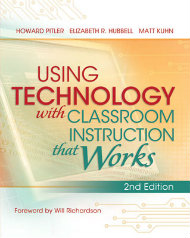The Why & How of Tech Tools
Using Technology with Classroom Instruction that Works
By Howard Pitler, Elizabeth R. Hubbell, and Matt Kuhn
(ASCD/McREL, 2012 Learn more)
One of the things I admire about Using Technology with Classroom Instruction that Works is the framework around which the content is built. The book focuses on the pedagogy behind the use of technology, and the emphasis is less on the tools (although the book is packed with examples) than on the rationale behind the tools. The book is marketed as a companion text to Classroom Instruction That Works, but I read this it as a separate resource, and you can too.

Teaching trumps tech
This book, with a timely introduction by Will Richardson, is the second edition, and the authors – Howard Pitler, Elizabeth R. Hubbell, and Matt Kuhn – acknowledge that the pace of change is outracing the pace of publishing (something I know all too well from editing my own collection of pieces around writing, technology and teaching).
And so, they frame the book this way: “Our intent is not to write a book about technology, but rather a book about using technology as one among several tools for providing good instruction. This way of thinking about technology is helpful for educators overwhelmed by the constant onslaught of the latest gadgets and applications. (2).”
I like that the framework for instructional practice is constructed around creating a supportive environment for learning, shifting into helping students to develop understanding of an idea or concept, and then moving into extending and applying that knowledge in ways that build off the instruction. The authors seek to weave technology concepts into the various phases of that instructional conceptual design, and for the most part, they succeed.
My only real complaint is that there are too many tools here, and if their intent was to make it easier for teachers and administrators (this book is published by ASCD so I assume that is the primary audience), it may in reality be a bit overwhelming to even look at the table of contents, which covers five pages. Teachers who dig in, however, will find plenty of examples and strategies that can provide a nice road forward into using technology to plan instruction, and also, to engage students in learning.
Kevin Hodgson is a sixth grade teacher in Southampton, Massachusetts, and is the technology liaison with the Western Massachusetts Writing Project. Kevin blogs regularly at Kevin’s Meandering Mind and tweets more often than is healthy under his @dogtrax handle.






































Hello Kevin, thank you for this thoughtful review. We hope that middle level teachers benefit from its applications and approach. While published by ASCD, the other two authors and I work at McREL. We will be giving an in-depth workshop around the book at McREL in Denver on Feb. 6-8. See http://www.mcrel.org/about-us/news-and-events/events/event-02_06_13 for more information.